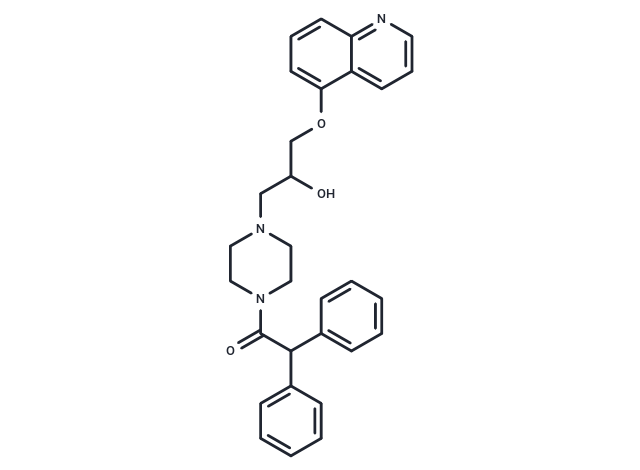Shopping Cart
- Remove All
 Your shopping cart is currently empty
Your shopping cart is currently empty

Dofequidar (MS-209 free base) is an orally active quinoline derivative that inhibits the efflux of chemotherapeutic agents and may overcome MDR by inhibiting ABCB1/P-gp, ABCC1/MDR-related protein 1, or both.

| Pack Size | Price | Availability | Quantity |
|---|---|---|---|
| 1 mg | TBD | 35 days | |
| 5 mg | TBD | 35 days | |
| 10 mg | TBD | 35 days | |
| 25 mg | TBD | 1-2 weeks |
| Description | Dofequidar (MS-209 free base) is an orally active quinoline derivative that inhibits the efflux of chemotherapeutic agents and may overcome MDR by inhibiting ABCB1/P-gp, ABCC1/MDR-related protein 1, or both. |
| In vitro | Dofequidar demonstrated significant effects in in vitro experiments, increasing chemosensitivity of SBC-3/ADM cells to VP-16, ADM and VCR in a dose-dependent manner. [1] At a concentration of 3 μM, Dofequidar effectively reversed docetaxel resistance in multidrug-resistant (MDR) cancer cells, while maintaining this concentration in plasma for more than 7 hours without observable toxicity. [2] In the acquired MDR tumor cell lines 2780AD and KB-C1, Dofequidar significantly reduced resistance to adriamycin (ADM) and vincristine (VCR). In addition, Dofequidar significantly enhanced the cytotoxicity of ADM and VCR in several human and mouse cell lines. In particular, in 4-1St cells, which are extremely resistant to ADM and VCR, Dofequidar at a concentration of 3 μM increased the cytotoxicity of ADM and VCR by 88-fold and 350-fold, respectively. [3] |
| In vivo | In severe combined immunodeficiency (SCID) mice lacking natural killer cells (NK cells), metastatic lesions were observed to form in the liver, kidneys and lymph nodes by intravenous injection of SBC-3 or SBC-3/ADM cells. In contrast, metastasis formation was significantly faster in SBC-3/ADM cells than in SBC-3 cells. The use of VP-16 and ADM had an inhibitory effect on metastasis caused by SBC-3 cells, but not by SBC-3/ADM cells. Although Dofequidar alone did not significantly affect metastasis caused by SBC-3 or SBC-3/ADM cells, it significantly reduced the metastatic burden of SBC-3/ADM cells in multiple organs when combined with VP-16 or ADM. [1] In a xenograft model of inherently resistant HCT-15 tumors, docetaxel alone at the maximum tolerated dose (MTD) demonstrated significant antitumor effects, which were further enhanced in combination with Dofequidar. In an MCF-7/ADM tumor xenograft model expressing large amounts of P-glycoprotein (P-gp), docetaxel at the maximum tolerated dose (MTD) did not exhibit antitumor activity on its own, but its growth inhibitory effect on MCF-7/ADM tumors was significantly enhanced in combination with Dofequidar. [2] Oral administration of Dofequidar in combination with ADM significantly increased the antitumor effect of ADM in subcutaneous transplanted Colon 26 and 4-1St tumor models in mice. The combination of ADM + Dofequidar demonstrated enhanced tumor suppression compared to ADM alone at the maximum tolerated dose (MTD). [3] |
| Alias | MS-209 free base, MS209 free base |
| Molecular Weight | 481.59 |
| Formula | C30H31N3O3 |
| Cas No. | 129716-58-1 |
| Smiles | O=C(N1CCN(CC1)CC(O)COC2=CC=CC3=NC=CC=C32)C(C=4C=CC=CC4)C=5C=CC=CC5 |
| Relative Density. | 1.228g/cm3 |
| Storage | keep away from moisture,store at low temperature | Powder: -20°C for 3 years | In solvent: -80°C for 1 year | Shipping with blue ice. |
| Solubility Information | DMSO: Soluble |

Copyright © 2015-2025 TargetMol Chemicals Inc. All Rights Reserved.